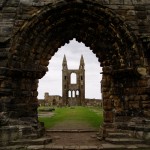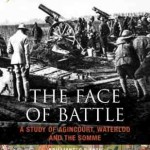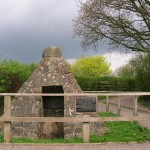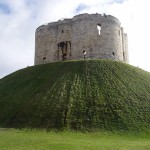It’s that strange part of the year, the in-between time that exists after the completion of one novel and before the beginning of the next. With the draft manuscript of Knights of the Hawk, the third book in the Conquest Series, now finished and on track for publication this October, I’m starting to look to
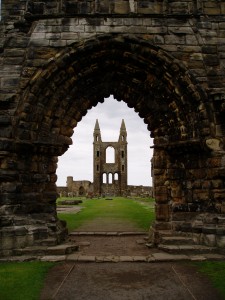
The ruins of St Andrews cathedral. At 119 metres (391 feet) in length, it’s the largest church ever to have been built in Scotland.
Being a historical novelist is all about bringing the past to life for a modern audience, so this conference seemed like the ideal chance to meet and share ideas with like-minded people from across the academic community who also happen to have the same love of the Middle Ages. And so I found myself in the company of 175 other delegates from 15 countries – some having travelled from as far afield as Australia, Korea and Canada – discussing how various aspects of the Middle Ages are represented today in literature, music, film, TV, climate change science and almost every other field imaginable.
I was there to deliver a paper entitled Representing the Middle Ages in Fiction, drawing upon my own experiences to discuss ways in which novelists might go about presenting their subjects in a historically responsible way. How rigorous should novelists be in their research? Can and should we hold them up to the same standards as professional historians? Accepting that a certain amount of invention and distortion is unavoidable in writing historical fiction, is there a certain point at which too much becomes unacceptable, and it descends into fantasy? What can historical fiction offer that non-fiction histories alone might ordinarily struggle to do?
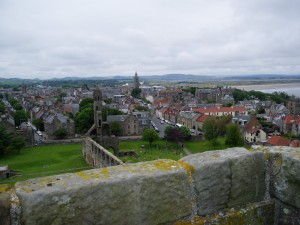
The town of St Andrews, as seen from the top of the 12-century St Regulus’ Tower, which stands amidst the cathedral ruins.
I also had the good fortune to meet and discuss writing with Felicitas Hoppe, a German novelist and recent winner of the prestigious Georg Büchner Prize – one of the most prestigious German-language literary awards – who gave a plenary lecture about the challenges of adapting medieval romances into fiction. Other brilliant lectures included James Robinson from the National Museum of Scotland speaking about the similarities between the cults of medieval saints and those of modern celebrities; Bruce Holsinger from the University of Virginia talking about how an extract from the Icelandic sagas has found its way into debates about global warming; and Patrick Geary from the Institute of Advanced Study, Princeton, examining how medieval ideas of European ethnicity still have political currency today.
Those were just a few of the highlights from the conference. More on those, and on the rest of my findings from my time in St Andrews, in Part Two of my report, coming soon!
One of the toughest challenges involved in writing about medieval warfare is that of describing what battle in that period was like: how it might have felt to be there, including not just the physical sensations but also the psychological and emotional. What would have been running through the combatants’ minds? What motivated and inspired
One of the toughest challenges involved in writing about medieval warfare is that of describing what battle in that period was like: how it might have felt to be there, including not just the physical sensations but also the psychological and emotional. What would have been running through the combatants’ minds? What motivated and inspired men like my protagonist, Tancred, to take up arms in the first place, and what gave them the confidence to risk their lives in the fray? Was it for money or fame that they principally fought, in the name of God or one’s king, or (more probably) was it a combination of all of these things?
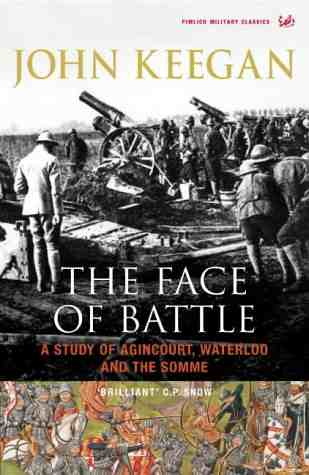 The historian John Keegan, who sadly passed away last year, explores similar themes in his pioneering book The Face of Battle, in which he analyses and compares the experience of combat in three major encounters of the last 600 years: Agincourt (1415), Waterloo (1815) and the Somme (1916). In particular he examines how the mechanics and logistics of conflict affected the psychology of the individual soldier – looking not just at the critical moments during the heat of combat, but also at the hours before battle was joined, and its aftermath once the dust has settled.
The historian John Keegan, who sadly passed away last year, explores similar themes in his pioneering book The Face of Battle, in which he analyses and compares the experience of combat in three major encounters of the last 600 years: Agincourt (1415), Waterloo (1815) and the Somme (1916). In particular he examines how the mechanics and logistics of conflict affected the psychology of the individual soldier – looking not just at the critical moments during the heat of combat, but also at the hours before battle was joined, and its aftermath once the dust has settled.
Keegan eschews analyses of strategy and tactics that many conventional military histories often involve, which – he argues – can sometimes misrepresent the ebb and flow of battle; instead he recognises the chaos and unpredictability inherent in war. The focus of his study is statedly not upon the respective generals and their abilities to lead and choose the correct course of action, but upon the lower ranks: a bottom-up rather than a top-down angle.
An advantage, too, of taking such a long view of the experience of battle is that he is able to highlight those aspects that have remained constant even over hundreds of years, in widely different fighting environments; and those which have altered as a result either of technological development – in weaponry, transport and communication, among other areas – or of societal changes.
A good example of the latter is the religiosity of the common soldier, which had declined during the age of the Enlightenment prior to Waterloo, only to re-establish itself in the Victorian age. The motivations of the men fighting in 1815 were thus vastly different to those of their counterparts only a century later. Prayer and faith in God helped many British soldiers combat their fears and reconcile themselves with the possibility of death in 1916, in a way and to an extent that their predecessors at Waterloo would not have been able to identify with, but which those at Agincourt very probably would.
One particularly ingenious feature of the book, which I can’t fail to mention, lies in the maps. Keegan juxtaposes the fields of battle firstly of Agincourt and Waterloo, and then of Waterloo and the Somme, depicting them on the same scale to demonstrate how the magnitude of battle has increased exponentially over the centuries.
Due to the outpouring of fiction in the military-historical sub-genre in the last couple of decades, accounts of past conflict illustrating the hardships and traumas faced by the front-line soldier are much more familiar than they once were. At the same time there has been a massive surge of interest in recent decades into the kind of bottom-up history favoured by Keegan: an interest that began in academia but which has filtered down into popular history as well, so that there has been an explosion in studies of this nature.
For both of those reasons The Face of Battle doesn’t seem quite quite as revolutionary a text as it probably did when it was first published in 1976. Nevertheless, it remains a thoroughly absorbing and eye-opening read, and one that I can highly recommend.
As many of you will have heard, the Festival of History at Kelmarsh Hall on 14-15 July had to be cancelled after heavy overnight rain led to the local river bursting its banks and flooding the site. If you want to get some idea of just
As many of you will have heard, the Festival of History at Kelmarsh Hall on 14-15 July had to be cancelled after heavy overnight rain led to the local river bursting its banks and flooding the site. If you want to get some idea of just how wet it was, take a look at the photos on the BBC History Magazine website.
The flooding meant that the planned Festival of Historical Writing also couldn’t go ahead, including the panel discussion in which myself and fellow writers Robyn Young, Angus Donald and John Man were due to talk about “the heroes of history”. My own chosen subject was William the Conqueror – not the most obvious choice for many people today, perhaps, although the Normans at the time certainly would have regarded him as a hero despite his chequered career.
As disappointed as I was to miss out on the chance to speak, and also to see the planned Battle of Hastings re-enactment, I can only imagine how disappointing it must have been for all those visitors who travelled many miles especially for the Festival only to be turned away. There has been some tentative talk of possibly resurrecting the heroes panel at some future event, although nothing has been confirmed. In the meantime I might present my case for the Conqueror here on the blog, so watch this space.
Thwarted by the Northamptonshire weather but still determined to see some history, I crossed the border into Leicestershire to visit Bosworth Battlefield, the site of the famous clash in August 1485 between the forces of Henry Tudor and King Richard III, which saw the latter lose his life and the former claim the crown of England (as Henry VII).
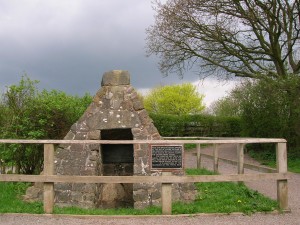
The well from which Richard III is said to have drunk before the Battle of Bosworth on 22 August 1485.
The later Middle Ages, the Wars of the Roses and the rise of the Tudor dynasty present largely unfamiliar territory for me, being mainly an early medieval specialist, but walking the mile-and-a-half-long Battlefield Trail that leads around the site gave me a real insight into the period. Display panels dotted around the site describe the historical context and tell the story of the battle, and also suggest how the countryside might have looked in the late fifteenth century and how the armies might have approached each other on that fateful summer’s day, taking into account recent research into the site.
The real brilliance, however, comes in the audio installations located at key points on the Trail, which describe how ordinary soldiers on both sides might have felt on the march to Bosworth and on the night prior to going into battle, exploring the tension and the anxiety in a way that really brings the battle to life. There is a small charge to get into the exhibition at the Heritage Centre, but it’s free to enter the Country Park and walk around the Battlefield Trail, which I would thoroughly recommend if you get the chance.
Who was the hero and who was the villain in the contest between Henry Tudor and Richard III? The site makes no judgements, but allows visitors to make up their own minds about the two rivals for the crown. Certainly some of the supporting players were less than savoury characters, such as the duplicitous Stanley brothers who betrayed Richard at the critical moment in order to secure greater glory and set themselves up as kingmakers. Perhaps there’s a novel in there somewhere…
*
The Bosworth Battlefield Heritage Centre is open from February to December; the Country Park is open all year round.
Last week I ventured northwards to York for the annual Jorvik Viking Festival. For the 27th year, Norsemen took over the city for February half-term week and set up camp in the streets, even bringing their longship into Coppergate Square for those queueing up outside the Jorvik Viking Centre to admire.
I was in York
Last week I ventured northwards to York for the annual Jorvik Viking Festival. For the 27th year, Norsemen took over the city for February half-term week and set up camp in the streets, even bringing their longship into Coppergate Square for those queueing up outside the Jorvik Viking Centre to admire.
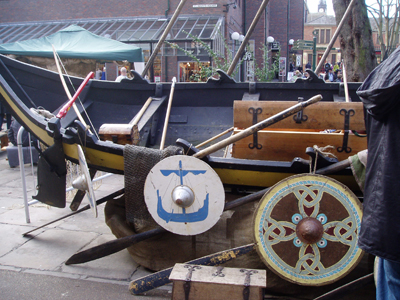
The Viking longship in Coppergate Square, outside the Jorvik Viking Centre.
I was in York to talk about Sworn Sword, the novel’s connection with the city, and what it was about York that made it such a battleground during the mid-eleventh century as English, Norman and Scandinavian forces all struggled to capture and control it. At the end I also gave a special sneak preview reading from the very first chapter of the sequel, which will be released in hardcover on 6 September (more details on that to follow soon).
York has a long history dating back to the Roman period. By the time of the Norman Conquest it was the second biggest city in England (after London): the chief town of the north of the kingdom; a major manufacturing centre for metalwork, woodwork, glass and jewellery; and a burgeoning port and trading hub with links all across Europe and beyond, even as far as Byzantium and Samarkand in modern-day Uzbekistan. In 1069 when Sworn Sword is set it would have been a fantastically vibrant place to be, with people from all cultures mixing together and a lot of wealth being brought in from abroad.
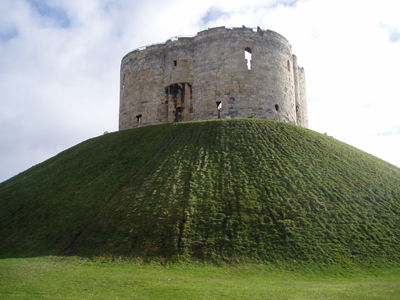
Clifford's Tower, York - the thirteenth-century keep that stands on the site of the original castle.
Militarily speaking, York was also a crucial strong-point, and whoever controlled it tended to hold sway over the vast province known as Northumbria that stretched from the Humber Estuary in the south to the borders of the Scottish kingdoms in the north.
For that reason it formed the location for some of the fiercest struggles for power witnessed in this period, both before the Conquest – the Battle of Stamford Bridge, for example, which was fought only a few miles away between the namesake kings Harold Godwineson of England and Harald Hardrada of Norway – and afterwards too. It’s not too much of an exaggeration to say that York was where in many ways the future of England was decided in those fateful years.
I visited the city a few years ago as part of my research for the novel, so that I could get a feel for the scale of the medieval city and the lie of the land. Not much of Conquest-era York survives today, but by walking the streets I was able to get a feel for the richness of the place’s history. On my return last week I also took the time to snap some pictures, the best of which you can see on this page!
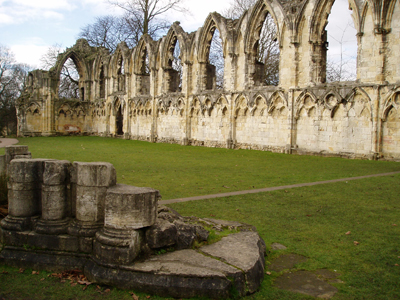
The ruins of St Mary's Abbey outside Bootham Bar to the northwest of medieval York.
One of the locations that I revisited last week was St Mary’s Abbey (pictured above), the ruins of which now lie in the Yorkshire Museum Gardens. St Mary’s was in its turn built on the site of an earlier foundation dedicated to St Olave in a district once known as Earlsburgh, which it is suggested received its name from a fortified palace belonging to the Anglo-Scandinavian earls of Northumbria that used to stand nearby.
That palace is the same one referred to in Sworn Sword as the residence of the real-life vicomte (sheriff) of York, William Malet, who was installed by King William I after the city was first captured by the Normans in 1068. Even though the site looks very different nowadays, somehow the knowledge that I was treading the same ground as my characters helped me visualise those scenes when I came to write the novel.
Thanks to the folks at York Archaeological Trust and the Jorvik Viking Centre for inviting me to come and talk. It was a pleasure to meet so many other historically-minded people and to share my love of this period. I hope it’s not too long before I find myself back in York. And for those of you reading this who have a special interest in all things Norse-related, the good news is that there are more Vikings to come in Books 2 and 3 – watch this space!
*
For information about other Viking- and medieval-themed events taking place in and around York, visit the Jorvik Viking Centre website.
This week I returned to the place where Tancred’s story begins – to Durham, where the city’s annual Book Festival has been taking place this month. An enthusiastic audience joined myself and my event host, Dr Giles Gasper, lecturer in medieval history at Durham University, for a discussion about Sworn Sword and its connection with
This week I returned to the place where Tancred’s story begins – to Durham, where the city’s annual Book Festival has been taking place this month. An enthusiastic audience joined myself and my event host, Dr Giles Gasper, lecturer in medieval history at Durham University, for a discussion about Sworn Sword and its connection with the city.
One of the questions I was asked was why I chose Durham in particular as the place to begin the novel. In fact the battle that forms the opening chapters was a real-life event that took place on or around 28 January 1069, and it’s spoiling none of the plot to say that it marked a significant turning-point in the story of the Conquest. Indeed this was the biggest defeat that the Normans had suffered since arriving on these shores more than two years previously.
Around Christmas 1068, William the Conqueror appointed Robert de Commines, Tancred’s lord, as Earl of Northumbria, the only part of England that had thus far refused to acknowledge him as king. Together with his army – the sources disagree on exactly how many men – Robert marched to subdue the recalcitrant northerners and take the province by force. Soon after arriving in Durham, however, the earl and his forces were routed in a surprise attack under the cover of darkness. The Normans were cut down in the streets and Robert himself was killed. There were few survivors.

View of the tower and north transept of Durham Cathedral.
Walking around the city on my visit there this week, I was reminded just how dramatic a location Durham is, and how its very geography makes it a fascinating setting for a battle. The castle and the cathedral that nowadays dominate the skyline had not yet been built by 1069, but the peninsula on which they are built would have made this a naturally defensible site, protected on three sides by water and by steep inclines that would make any direct assault difficult except from the north. While there is little explicit evidence for any fortification on the site before then, to my mind it seems likely that a stronghold or fastness of some kind must have existed, as I have suggested in Sworn Sword.
Whether or not such defences existed at the time, the very fact that the Northumbrians were able to defeat the Normans here was by all accounts an impressive achievement, and a famous victory. Conversely, to the Normans this would have been seen as a major setback to their conquest of the north. The loss of so many men in one night would not only have dented their confidence but in addition must have placed a very real strain on their defences, especially once the enemy began their southwards march not long after.
The Durham connection was just the starting-point of a great discussion about the Norman Conquest and historical fiction. Topics ranged from the use of Old English place-names in the novel to getting inside the medieval mind, the importance of research and site visits, and my plans for future novels in the series. I certainly enjoyed myself and I hope that my audience did too.
Many thanks to all those involved in the organisation and smooth running of this year’s Festival. Particular thanks also go to my host for the event, Dr Gasper, who generously gave his time after the talk to give me an exclusive tour of Durham Castle’s Norman chapel, which is normally off-limits to the public. One of the earliest stone chapels of its kind known to have been built in England, it is thought to date from the 1080s when it was attached to the house of the Bishop of Durham, who probably used it as a private place of worship. It was a privilege to be allowed access to such impressive architecture, and an unexpected bonus on my northern travels.
I’m hoping to be back in Durham at some point in the New Year, and in February I’ll also be visiting York, the centrepoint for much of the action in Sworn Sword, where I’ll be giving a talk at the Jorvik Viking Festival – more details to follow in due course. Keep checking my Events page for further information about all my upcoming appearances.
*
The Durham Book Festival runs until tomorrow, Sunday 23 October, with further events for young writers continuing through half-term week to Friday 28 October. For more information visit the Festival website.
All this week the Historical Novel Society has been commemorating the anniversary of the Battle of Hastings, which took place 945 years ago today. As well as running a 1066-themed competition, the Society has also collected together a series of specially written articles about some of the lesser known figures of the Norman Conquest –
All this week the Historical Novel Society has been commemorating the anniversary of the Battle of Hastings, which took place 945 years ago today. As well as running a 1066-themed competition, the Society has also collected together a series of specially written articles about some of the lesser known figures of the Norman Conquest – figures who perhaps deserve to be better remembered – by novelists and historians specialising in the period.
Since my own series of novels is told through Norman rather than English eyes, my choice of subject is one of the invaders: William fitz Osbern, the Conqueror’s oldest and most loyal advisor, who acted as his right-hand man in Normandy and England both before and after the invasion.
Fitz Osbern was of a similar age to his namesake Duke William, which is to say he would have been around forty at the time of the invasion in 1066. The two probably grew up together in the ducal household, where his father had served as steward: a role that Fitz Osbern himself would later inherit. He and the duke formed a close friendship, and by 1066 he was one of the most powerful men in Normandy, with extensive lands centred around the town of Breteuil. He was also a regular part of the duke’s retinue, as evidenced by the large number of charters he attested.
In fact if we are to believe later sources, the Conquest might not have happened at all had it not been for Fitz Osbern. According to the twelfth-century poet and historian Wace, after news arrived at the Norman court that Harold had seized the throne, it was he who convinced the uncertain and despondent Duke William of the need to follow through with his intention to invade England and claim the crown. Indeed he went so far as to openly chastise him, saying:
“A worthy man must not begin anything or set anything in motion only to abandon it. Either start something and bring it to fruition or leave everything without more ado.”
Convincing William was the first challenge; the second was to secure the support of the other Norman barons, many of whom were less than enthusiastic about the proposed invasion, which they saw as a risky adventure. Again, as Wace tells the story, it was Fitz Osbern who brought order to the squabbling barons and persuaded them contribute the necessary men and ships.
Exactly how much truth lies behind either of these tales is hard to say; they originated many years after the events and so must be taken with a pinch of salt. At the very least they are suggestive of Fitz Osbern’s influence, showing that he was remembered in later generations for his extensive authority and for the respect he commanded from the Conqueror, in whose company he could speak freely: as a friend and equal rather than as a vassal.
After 1066 Fitz Osbern’s estates were much increased and his authority was extended across much of southern England. Along the Welsh borders he became known as a great builder of castles, and he was also later made castellan at York, although his activities elsewhere suggest that he cannot have spent much time in those parts of the country.
In 1067 the newly-crowned king returned to his native land to celebrate his victory. Fitz Osbern was entrusted, along with the Conqueror’s half brother Odo, with the governance of England, and in the king’s absence the two men became the enforcers of his rule. “Swollen with pride”, as the English-born chronicler Orderic Vitalis describes them, they proceeded to subdue the kingdom in brutal fashion. As Orderic relates:
When their men-at-arms were guilty of plunder and rape, they protected them by force and wreaked their wrath all the more violently upon those who complained of the cruel wrongs they suffered.
The other side of Fitz Osbern’s character thus presents itself: as well as being loyal and reliable, he also possessed a ruthless streak. For these acts of violence Orderic roundly condemned him; Wace later described him as “a very arrogant man”. Indeed it was his arrogance which was to prove his undoing.
In 1071 a struggle for the succession broke out in neighbouring Flanders between the young Count Arnulf and his uncle Robert. Fitz Osbern, who was at the time in Normandy governing the duchy with Queen Matilda, responded by riding to the count’s aid, albeit “as if to a tournament” with only ten knights accompanying him. At Cassel in late February he was ambushed and killed: an abrupt and embarrassing end for such a famed and powerful man.
How his career might have played out had he not died then, we can only speculate. Would his power have extended even further over the years to come as the nascent Anglo-Norman realm was consolidated?
For all his brutality, pride and recklessness, Fitz Osbern was remembered by contemporaries as a man of good character, great physical prowess and unwavering loyalty. Even Orderic conceded that he was greatly mourned by the Normans, and found space to admire his bravery and generosity. Perhaps the greatest commendation of all, however, comes from another twelfth-century historian, William of Malmesbury, who described Fitz Osbern as “better than the very best princes” – high praise indeed.
*
For more articles about some of the lesser known protagonists of the Conquest period, as well as links to other online resources for 1066, visit the HNS Competitions blog. To find out more about the Historical Novel Society itself, visit its website.

